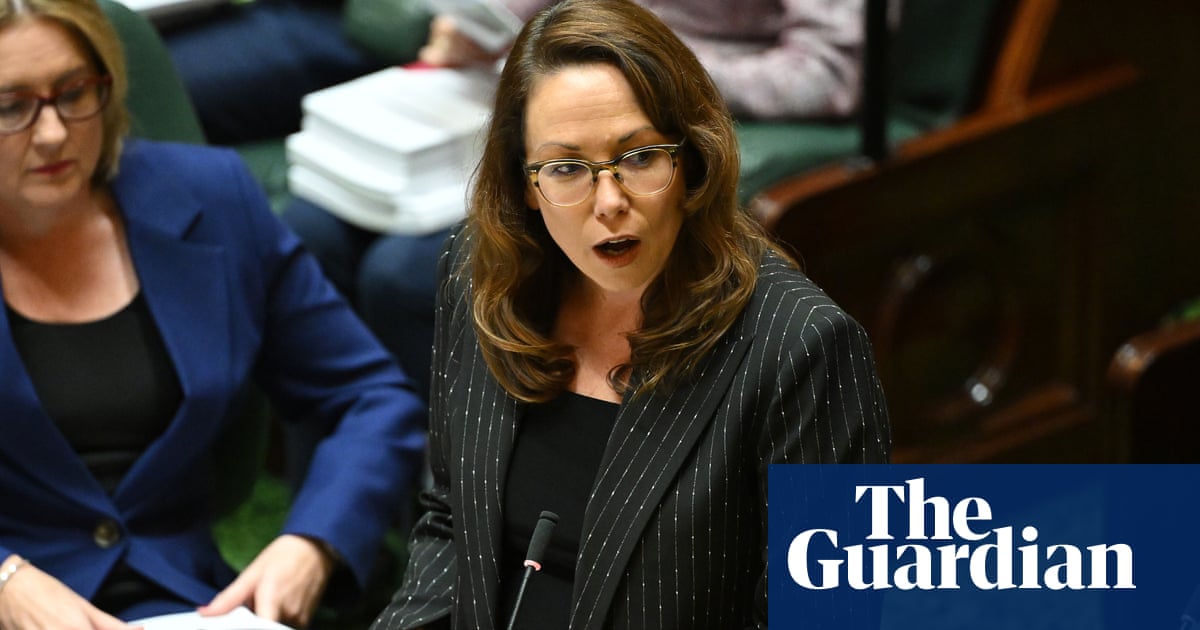The Victorian treasurer has used a GST windfall and $3.3bn in cost savings – including cutting swathes of public sector jobs – to fund a cash splash pitched at families in her first budget.
The 2025-26 budget, handed down on Tuesday, includes an additional$11.1bn for health, $2bn in early childhood education, $1.5bn for new and upgraded schools and $2.3bn in cost-of-living measures, including the already-announced $320m plan to providefree public transport for under-18s.
The treasurer, Jaclyn Symes, said the government could afford the commitments as it was “firmly on track” to shore up the state’s finances post-pandemic,spruiking a $600m operating surplusthis financial year, as well as a “reduction” in net debt when compared to the size of the Victorian economy as a whole.
“We can deliver these investments because of our responsible approach to financial management,” she said in her speech to parliament.
Part of this “responsible approach” includes $3.3bn over four years in “cost savings and efficiency measures” across the public sector, including reducing duplication and back-office costs across departments and winding back “non-priority” programs.
About 1,200 public sector roles would be affected, Symes told reporters, admitting that “this will impact individuals”.
She refused to outline which departments would be affected, but said the cuts would not include frontline services.
Sign up for Guardian Australia’s breaking news email
The budget, however, reveals wide-range cost-cutting across seven of the 10 government departments in the next financial year, including lower employee expenses. Only the departments of health, education and government services are spared.
But major changes to the public service – and further job losses – will not be known until 30 June, when a final report into the sector is handed to government.
“That will identify additional savings,” Symes said. “There will be further job reductions, we flagged up to 3,000.”
She suggested proliferating government bodies would be on the chopping block.
“Victoria has over 500 entities and 3,400 public boards and committee – you can’t tell me that there’s not some fat in there,” Symes said.
The budget shows employee expenses – which make up about a third of the government’s total spending – will climb to $44.1bn in 2025-26.
But it forecasts average annual growth over the forward estimates of just 2.9% in employee expenses, which it says is “consistent with requirements of service delivery and enterprise bargaining agreements”.
Sign up toBreaking News Australia
Get the most important news as it breaks
after newsletter promotion
Economists are sceptical of the government’s capacity to rein in growth in employee expenses. This includes Michael Brennan, a former deputy secretary of Victoria’s Treasury and chair of the Productivity Commission, who last week wrote that across all budgets since 2015-16, an average 3.2% growth has been forecast, when in reality it has been closer to 7%.
Symes has not banked the GST windfall the state received from the commonwealth – $4.63bn over the next three years.
A reconciliation of expenses with December’s mid-year update shows Victoria received almost $3bn from the federal government for 2025-26, including $1.69bn in GST.
The state also spent $3.11bn more than planned, the figures show, which Symes defended by saying “as a Labor government we respond to what Victorians need”.
Victoria’s cash deficit has also grown from the December update by $2.87bn and the state continues to run them across the forward estimates.
But as with all state governments, it spruiks itsoperating surplus, which does not include infrastructure and other capital spending. On this front, the surplus grows to $1.9bn in 2026-27, $2.4bn in 2027-28 before slightly dipping to $1.5bn in 2028-29.
Debt continues to grow across the forward estimates, from $167.6bn this financial year to $194bn in 2028-29. By 2028-29, interest payments on state debt are forecast to total $10.56bn – almost as much as the $11.3bn it estimates it will spend on public order and safety in the same year.
The budget also reveals Victorians pay more tax per person than any other state or territory, just above New South Wales.
But there were no new or increased taxes in the budget, which would likely be a relief to businesses which have been lumped with several in recent years to help pay down the state’s debt.
